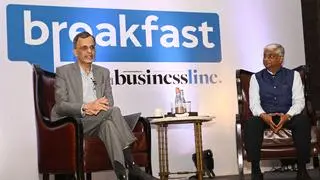The Indian economy is projected to grow at a 6.7 per cent -7 per cent rate in the fiscal year ending March 31, 2024, several economists said, upping their projections after the country blew past growth estimates for the July-September quarter.
The country's economy expanded 7.6 per cent in the July-September quarter, trouncing estimates of a 6.8 per cent rise, data released on Thursday showed.
Stronger-than-expected growth in the first half of the year, along with continued government spending and some revival in private investment has prompted economists to raise their growth forecast to higher than the government's estimate of 6.5 per cent.
"With 7.7 per cent real GDP growth in the first half of 2023-24, the overall growth for full fiscal would be around 7 per cent...though there are chances that it may cross the 7 per cent mark," said Saumya Kanti Ghosh, chief economist at State Bank of India. He had an earlier forecast growth at 6.7 per cent.
The government stuck to its 6.5 per cent growth forecast for the year, but chief economic advisor V. Anantha Nageswaran said he was "more comfortable with an upside to this projection than before".
Citigroup revised its growth forecast for the financial year upwards by 50 basis points to 6.7 per cent citing a pick-up in investment activity.
Gross fixed capital formation, an indicator of investment, rose 11 per cent in the July-September quarter.
"This reaffirms our view of sustained investment recovery," the Wall Street bank's chief India economist Samiran Chakraborty said in a note.
"While the 13.3 per cent growth in construction gross value added indicates public infrastructure/residential capex led investment growth – such strong gross fixed capital formation data might also suggest an element of private capex recovery," Chakraborty said.
DBS now sees growth in the current financial year at 6.8 per cent from 6.4 per cent earlier.
"There was a broad-based improvement in investments, reflecting higher state and centre spending alongside recovery in the real estate sector and inventory demand ahead of festivities," said economist Radhika Rao in a note.
"This made up for the softness in consumption spending and a negative contribution by net exports".
Consumption remained weak, growing just 3.1 per cent in the second quarter of the year signalling that parts of the economy are still to recover.
"Rural demand remains weak, reflecting low real wage growth and uneven monsoon," said Gaura Sen Gupta, economist at IDFC First Bank Economics Research, which has upped its growth forecast for the year to 6.7 per cent from 6.2 per cent earlier.








Comments
Comments have to be in English, and in full sentences. They cannot be abusive or personal. Please abide by our community guidelines for posting your comments.
We have migrated to a new commenting platform. If you are already a registered user of TheHindu Businessline and logged in, you may continue to engage with our articles. If you do not have an account please register and login to post comments. Users can access their older comments by logging into their accounts on Vuukle.